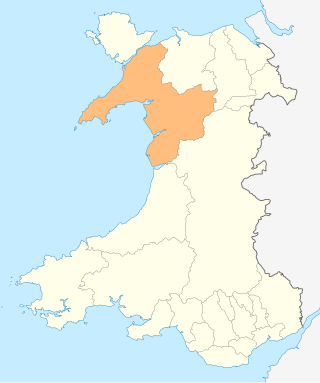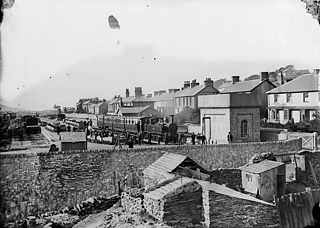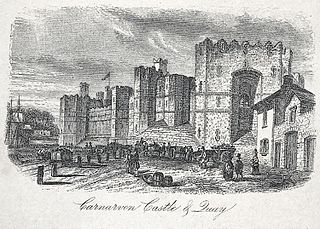
Caernarfon is a royal town, community and port in Gwynedd, Wales. It has a population of 9,852. It lies along the A487 road, on the eastern shore of the Menai Strait, opposite the island of Anglesey. The city of Bangor is 8.6 miles (13.8 km) to the north-east, while Snowdonia (Eryri) fringes Caernarfon to the east and south-east.
Carnarvon and Caernarvon are forms of the name Caernarfon which are no longer used for the town in north Wales, but remain in use in other contexts. The first two forms are in English orthography and the third is the Welsh spelling, adopted in English since the 1970s. Most places and things named after Caernarfon use one of the former spellings.

Dinas is a station on the narrow gauge Welsh Highland Railway, which was built in 1877 as the North Wales Narrow Gauge Railways Moel Tryfan Undertaking to carry dressed slate for trans-shipment to the LNWR. Passenger services ceased on 26 September 1936 until which time Dinas had been a joint station, known as Dinas Junction with the LNWR and later the LMS. In 1951, British Railways closed their part of the station but the line through the station remained open until the line from Caernarvon to Afon Wen was closed in 1964. The trackbed was subsequently developed as the Lôn Eifion tourist cycle route.

Criccieth railway station serves the seaside town of Criccieth on the Llŷn Peninsula in Gwynedd, Wales.
The Carnarvonshire Railway was a railway connecting Caernarvon with Afon Wen.

Caernarvon railway station was a station on the former Bangor and Carnarvon Railway between Caernarfon, Gwynedd and Menai Suspension Bridge near Bangor. The station was closed to all traffic in January 1972. The station has since been demolished and the site redeveloped.

Pontrhythallt was a railway station in the village of Pont Rhythallt, Gwynedd, Wales. This station opened in 1869 and closed for regular passenger services in 1930, but trains continued to pass through until the last goods train of all on 3 September 1964, which delivered a panel of lap fencing.

Brynkir railway station was opened by the Carnarvonshire Railway on the western edge of the village of Bryncir, Gwynedd, Wales.

Penygroes railway station was located in Penygroes, Gwynedd, Wales.

Groeslon railway station served the village of Groeslon, Gwynedd, Wales. It operated first as part of the Nantlle Tramway and afterwards as a railway under the auspices of several different companies. The station and line closed on 7 December 1964 as recommended in the Beeching Report.
Llanberis railway station was located in Llanberis, Gwynedd, Wales. It was a short walk from the Llanberis station of the Snowdon Mountain Railway. It opened 1 July 1869, and closed for regular passenger services in 1930. But it was still used by summer excursion trains until 7 September 1962 and freight services until 3 September 1964.

Cwm-y-Glo railway station served the village of Cwm-y-glo, Gwynedd, Wales, at the north-west end of Llyn Padarn. The station was closed for regular passenger services in 1930 but trains passed through until September 1964.

The River Rhythallt is a river in Gwynedd, North Wales whose source is Llyn Padarn. It flows in a northwesterly direction past the village of Brynrefail, Gwynedd and changes its name to Afon Seiont downstream of Pont Rhythallt in Llanrug. The Afon Seiont eventually reaches the sea at Caernarfon. The river has a broad flood plain which occasionally threatens homes in the village of Cwm-y-glo.

Llanrug is a medium-sized village and community in Gwynedd, north-west Wales. It lies about 4 miles (6.4 km) to the east of Caernarfon, 7 miles (11 km) south of Bangor and 3 miles (4.8 km) northwest of Llanberis. It is the largest populated village in the Arfon area of Gwynedd, Wales. The old name of the village was Llanfihangel-yn-y-grug, derived from Eglwys Sant Mihangel, which is situated about half a mile west of the village.

Cwm-y-glo is a small village in Wales, 4+1⁄2 miles (7 km) east of Caernarfon, between Llanberis and Llanrug. It is in the Arfon Parliamentary constituency, the community of Llanrug, and the Gwynedd Council electoral ward. Cwm-y-glo ward includes Ceunant and Pont-rug and has a population of around 1,000.
The Bangor and Carnarvon Railway was a railway company promoted to build a branch railway connecting Caernarfon with the main line at Bangor, in north-west Wales. It opened in 1852 as far as Port Dinorwic and was extended to Caernarfon later in the same year.
Padarn Halt was a passenger only railway station located in Llanberis, Gwynedd, Wales, on the western shore of Llyn Padarn. It opened on 21 November 1936 and closed on the outbreak of the Second World War. The line through the station remained in use for excursions until 1962 and for freight until 1964; it was lifted in 1965.
Caernarvon (Morfa) was the temporary western terminus of the Carnarvon and Llanberis Railway, located on the southern fringe of Caernarfon, Gwynedd, Wales.

Nantlle was a railway station located in Talysarn, a neighbouring village to Nantlle, in Gwynedd, Wales.

Carnarvon Castle railway station was opened in 1856 by the narrow gauge Nantlle Railway near the foot of what is today the Allt Y Castell which slopes down to Caernarfon's harbour area. It was the line's northern terminus and was the closest of Caernarfon's ultimately five stations to the historic town centre.














